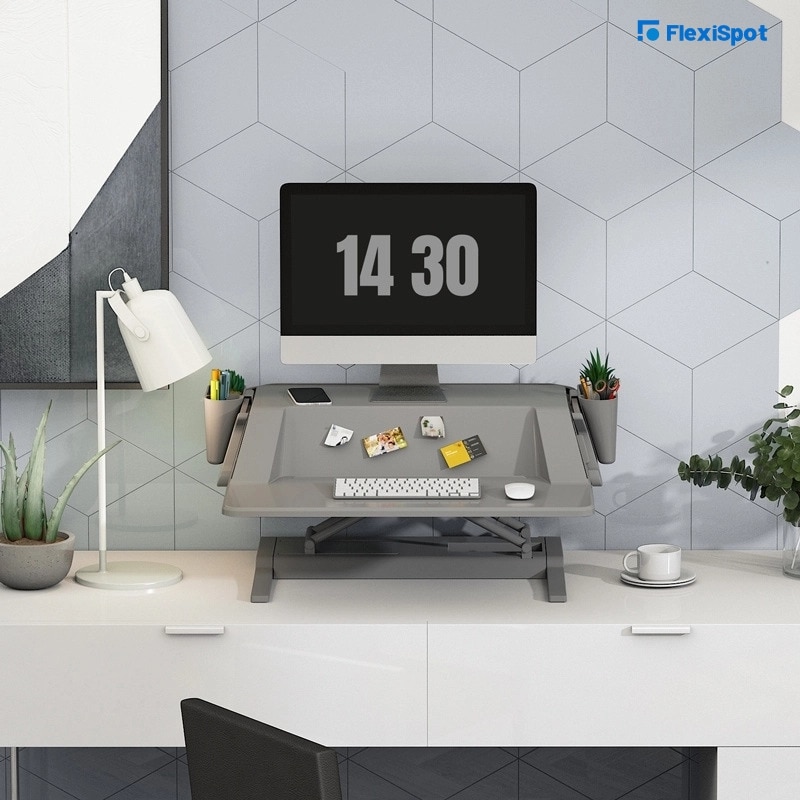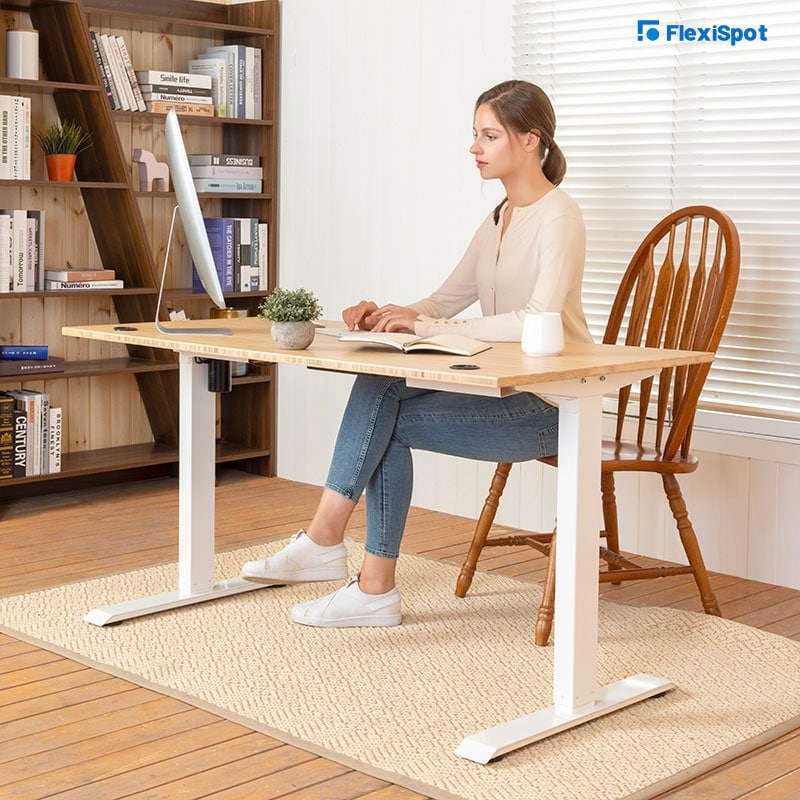To someone who has to stand all day at work, a desk job might be the ideal job where one gets to sit and relax. As nice as that sounds, it's not all that it's cracked up to be. A desk job where you've got to sit for several hours at a stretch is as bad as a standing job. Sitting in one place in the same posture can put you at risk of many health problems.
One of the biggest consequences of working a desk job is poor blood circulation. When you're sitting in your chair for long hours, your body is bent at the lower back and knees, which makes it difficult for the blood in your lower body to flow back to the heart. One of the most prominent signs of poor blood circulation is swollen feet. You may even feel a strong tingling sensation in your extremities (feet and hands) after long hours of immobility. It's when your muscles fall asleep due to a lack of any physical activity for too long.
You may not take swelling in the feet or the pin and needle sensations in your feet and hands very seriously, but poor blood circulation has numerous long-term health risks as well, including blood clots and Deep Vein Thrombosis (DVT) can lead to a stroke. You may not know, but sitting in the same posture for too long may be killing you without your knowledge. Now, that's scary!
But we don't mean to scare you. We're here to help you with some ways in which you can prevent poor blood circulation while working a desk job. Let's see how you can make your time at work less painful and less risky.
Use an Ergonomic Standing Desk
One of the most efficient ways of preventing poor blood circulation is using an ergonomic standing desk that allows you to work while standing. When you are standing, the muscles of your legs contract and expand to maintain balance and keep you from tripping and falling. One of the biggest reasons for poor blood circulation in the lower body is lack of movement. When you're sitting, you're constantly in the same position. Your feet are resting on the floor, and your body is in absolute balance. There's no reason for the muscles to stay active in this case.
However, with a standing desk, you aren't moving, but your muscles are active. The muscles won't fall asleep as long as they're active. And as long as the muscles are active, there will be an active exchange of oxygen between muscle cells and the blood, thereby ensuring that the blood flow to the lower body isn't compromised.
Take Breaks to Break up How Much You Sit
If you're working a desk job, you'll be sitting in your chair for most of the day, which is what's causing the poor blood circulation in the first place. However, you can prevent poor blood circulation by taking breaks between sittings. You should take breaks every 45 to 60 minutes. Walk around the office, grab a coffee, talk to your colleagues, use the toilet, or simply walk to the terrace or porch to take a breath of fresh air. You can even head out for a walk during your lunch break to enjoy lunch in a nearby park or a café down the lane. The whole point is to take a break and not to sit for a while.

One way you can alternate between sitting and standing without having to take a break from work is using a sit-stand workstation. Sit-stand workstations are specifically designed for the purpose of facilitating people who've to either sit or stand all day. These workstations can be used as regular desks that you use while sitting or raised to convert into a standing desk on which you can work while standing. How super convenient is that?
Try Active Sitting
When you're seated in a comfortable chair, your muscles relax. It means they don't remain active because there's not much work for them. Your body is balanced when you're seated in a comfortable chair. This can lead to poor blood circulation through the lower body. However, if you replace your chair with a padded stool, you can prevent poor blood circulation that's linked to desk jobs. These stools don't have a backrest or armrests, so you've got to maintain your balance consciously. It keeps your muscles active, which automatically keeps the blood flowing. Active sitting is a great way to keep the muscles of your legs and hands at work. Your leg muscles will work to maintain balance, and the muscles of the arms will work more when there's no armrest to rest and relax.
Stretch
No, we aren't suggesting you spread a yoga mat in your office and stretch like you do when you're working out. Instead, all you need to keep the blood flowing adequately throughout your body is by doing simple stretches that you can do while using your work chair as the balance point. Stretch your legs and arms to overcome any muscle fatigue that may be building up over the hours you've been working.
Make Sure Your Work Chair is Adjusted Right
One thing that not many people know about their work chairs is that you can adjust not only the height and the back position of the chair, but you can also change the angle of the seat. Make sure that the front lip of your work chair is either set at a neutral angle or slightly towards the downward position. You may wonder how is that going to prevent poor circulation when working a desk job.
Well, if the front lip of your seat is pointed upwards, the edge will press into the backside of your knees and thighs. You may not know, but this many large blood vessels pass through this region. If this area is pressed, it can really hinder blood circulation. When the seat is titled a bit downwards, the backside of your knees and thighs won't be pressed, and the blood flow won't be compromised.
Use Compression Socks
Muscle fatigue following a long day at work is real. Sitting for 8 to 9 hours a day isn't easy. If there's not much you can change about your job, you should start wearing compression socks to work. These are special socks that hug your legs from feet to knee up. Compression socks apply an omnidirectional pressure on the legs that's very gentle.
The feet are pressed more than they would if you were wearing regular socks. This pressure enhances blood circulation. Compression socks ensure that the heart is able to pump blood through the legs and the blood is able to flow back to the heart. They also prevent the fluid from leaking from the blood capillaries, thereby preventing edema and swelling of the feet.
Make a Habit of Drinking Plenty of Water
Did you know that your body tends to save energy by decreasing blood circulation when you're dehydrated? One way to prevent poor blood circulation when working a desk job is drinking plenty of water throughout the day. It'll help you feel fresh, energetic, and more productive and will also ensure that your muscles don't get fatigued due to poor circulation of blood.
Use a Footrest
You can also try using a footrest. By keeping your legs at a raised level, the muscles at the back of your leg remain active as they're extended more than they would have you been placing your feet on the floor. According to a study, placing your feet at a footrest inclined at an angle of 30 degrees can reduce the swelling by 1% by ensuring active blood flow through the legs while you're sitting.
Most of the jobs today require people to sit in one place. Most of the work is done through computers. From communication to calculations, everything is automated. People don't move about their offices like they once used to for communicating with their fellow employees. Everything today is done through emails and instant messengers.
Sedentary lifestyles, though, sound less tiring, aren't doing much good to our health which is why we should find ways to stay physically active. A sedentary lifestyle is contributing to an increased occurrence of health complications which is why you need to start thinking beyond the temporary comfort. Being physically active benefits us physically, and it has a positive impact on mental wellbeing as well.
If you do all things right, you can prevent poor blood circulation when working at a desk job. Your days at work will feel less tiring and exhausting, and you'll go home fresher. Change the way you sit and work and see the difference for yourself. It's time you start looking after yourself consciously!







